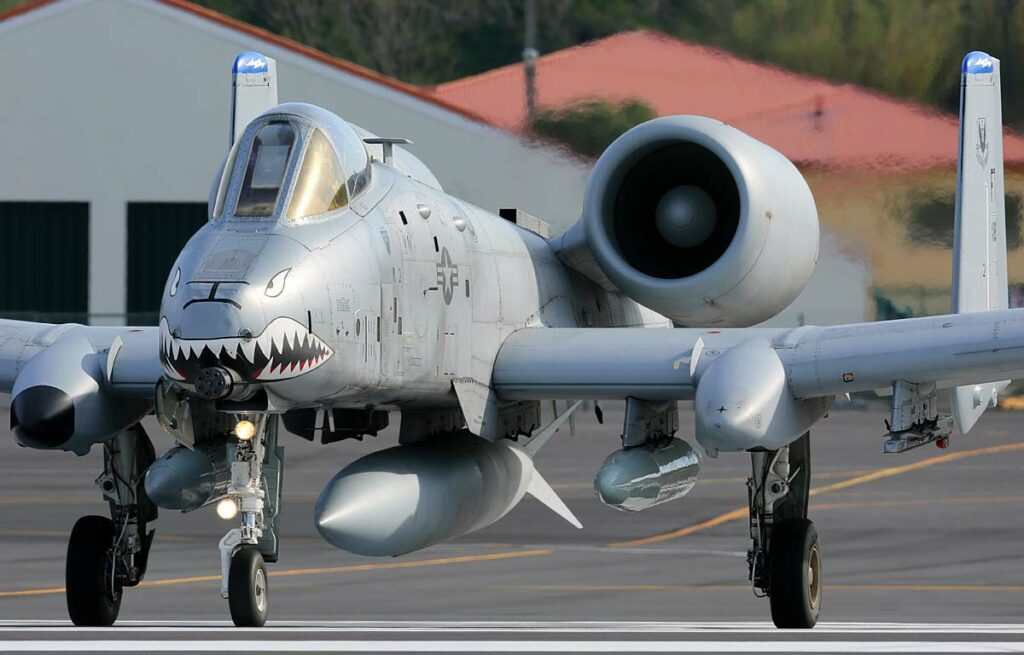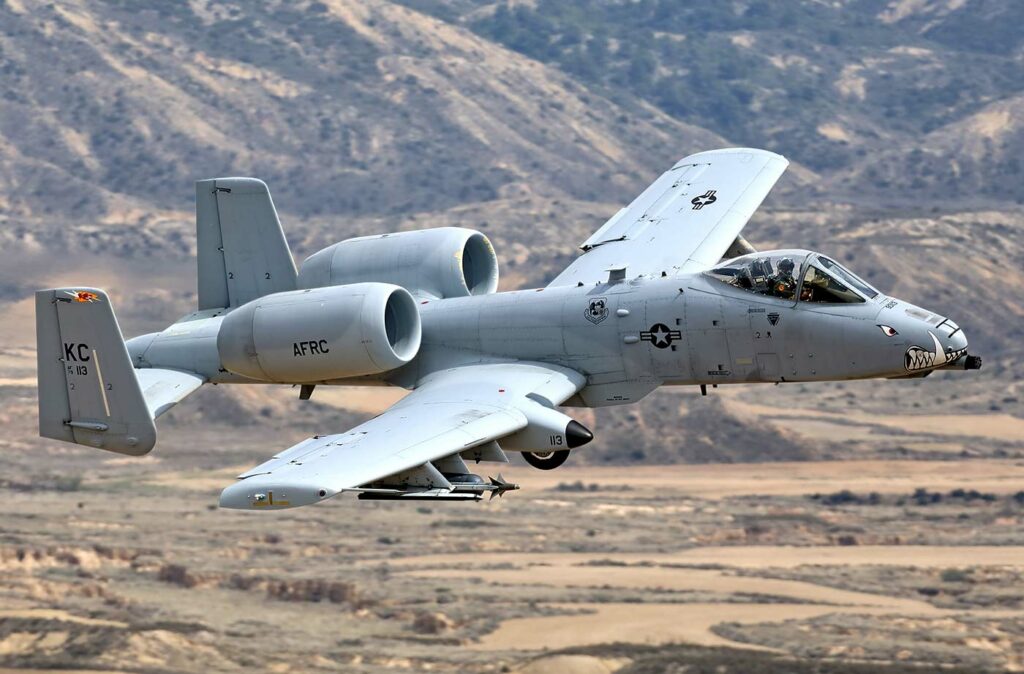A-10 Thunderbolt II: Close air support aircraft with superior tank-killing capabilities.
In brief
The A-10 Thunderbolt II, known as the Warthog, is a single-seat, twin-engine jet aircraft developed by Fairchild Republic for the United States Air Force. Primarily designed for close air support (CAS) of ground forces, the A-10 is highly effective at attacking tanks, armored vehicles, and other ground targets. It is notably equipped with a GAU-8 Avenger, a heavy rotary cannon that forms a substantial part of the aircraft’s frontal area. The A-10 is built for short takeoffs and landings, featuring a maximum speed of 439 mph (706 km/h) and a range of 800 miles (1,287 km), extendable with refueling. Its durability, 11 hardpoints for weapons payload, and up to 16,000 pounds (7,257 kg) of mixed ordnance ensure its effectiveness in various combat scenarios.

History of the Development of the Fairchild Republic A-10 Thunderbolt II (Warthog)
In the late 1960s and early 1970s, the U.S. Air Force recognized the need for a dedicated aircraft to provide effective close air support (CAS) to ground forces. This requirement was driven by the experiences of the Vietnam War, where the lack of specialized CAS aircraft became evident. The A-X program, later to become the A-10, was initiated to fill this gap with a focus on enhancing survivability and lethality in battlefield conditions.
Fairchild Republic’s A-10 Thunderbolt II was selected in 1973 after a competitive bidding process involving several other manufacturers. The design emphasized ruggedness, low-cost maintenance, and the ability to inflict significant damage to ground targets, particularly armored vehicles. The aircraft first flew on May 10, 1972, and was introduced to the U.S. Air Force in March 1976.
The development of the A-10 was a response not only to the operational deficiencies observed during previous conflicts but also to the Cold War climate, where the possibility of large-scale armored engagements in Europe was a significant strategic concern. The A-10 was specifically designed to counter massive tank invasions, a scenario prominently feared in NATO’s strategic planning against Warsaw Pact forces.
Design of the Fairchild Republic A-10 Thunderbolt II (Warthog)
The A-10’s design is characterized by its high-wing layout, which provides excellent visibility to the pilot and allows for short takeoff and landing capabilities. The aircraft measures approximately 16 meters in length with a wingspan of 17.5 meters. It is powered by two General Electric TF34-GE-100 turbofan engines, providing up to 9,065 pounds of thrust each, which are mounted in pods on the rear fuselage to reduce the risk of foreign object damage from rough fields.
One of the most distinctive features of the A-10 is its GAU-8 Avenger autocannon. This 30 mm rotary cannon is one of the largest and most powerful aircraft cannons in the U.S. arsenal, capable of firing large depleted uranium armor-piercing shells. The airframe design incorporates 540 kilograms of titanium armor to protect the pilot and critical flight systems, enhancing its battlefield survivability.
The A-10’s ability to carry a wide variety of ordnance on its 11 hardpoints, including laser-guided bombs, cluster bombs, AGM-65 Maverick missiles, and ECM pods, makes it extremely versatile in combat. However, its relatively low speed and older technology mean it is vulnerable in environments with heavy anti-aircraft defenses.
Performance of the Fairchild Republic A-10 Thunderbolt II (Warthog)
The A-10’s performance is optimized for low-speed, low-altitude flight, which is essential for the close air support role. It can fly at speeds up to 439 mph (706 km/h) and has a service ceiling of 45,000 feet. The aircraft’s range of 800 miles can be extended to approximately 2,580 miles with aerial refueling.
In terms of raw power and speed, the A-10 does not compare with faster, more agile fighter aircraft. However, its value lies in its endurance, armament capacity, and the ability to loiter over battlefields, providing sustained support to ground forces. The Warthog’s design allows it to take significant damage and continue flying, a critical feature given its operational environment.
Variants of the Fairchild Republic A-10 Thunderbolt II (Warthog)
The A-10 has seen several variants over its service life. The A-10A is the original model, while the A-10C includes upgraded avionics and systems for improved precision and network-centric warfare. The OA-10 variant focuses on forward air control duties, directing other aircraft in CAS roles.

Military Use and Combat of the Fairchild Republic A-10 Thunderbolt II (Warthog)
The operational history of the A-10 Thunderbolt II, particularly in conflict zones such as the Gulf War, the Balkans, Afghanistan, and Iraq, underscores its strategic importance as a close air support aircraft. Initially during the Gulf War, the A-10 demonstrated its effectiveness in anti-armor roles, successfully neutralizing over 900 Iraqi tanks. This capability was pivotal in reducing the combat effectiveness of the Iraqi forces, thereby contributing significantly to the Coalition’s military success.
In the Balkans during the 1990s, the A-10 was deployed to support peacekeeping and enforcement operations. Its ability to loiter for extended periods above conflict zones, coupled with its accurate firepower, made it an essential tool for supporting ground operations and enforcing no-fly zones. Its missions typically involved close coordination with ground units, providing immediate air support against hostile ground movements and fortifications, which were often entrenched within civilian areas.
The conflicts in Afghanistan in 2001 and Iraq in 2003 further tested the A-10’s capabilities in varied terrain and combat situations. In Afghanistan, the A-10 was crucial in mountainous battles, providing close air support to ground troops engaged in operations against Taliban and Al-Qaeda forces. The ruggedness and responsiveness of the A-10 proved advantageous in the harsh, mountainous landscape where fast-moving jet fighters would have been less effective.
The introduction of the A-10C variant brought significant technological enhancements that increased the aircraft’s operational effectiveness. Upgrades such as advanced targeting pods improved the accuracy and lethality of the A-10, allowing for better engagement with moving targets and reducing collateral damage. Enhanced communications systems facilitated better integration into contemporary network-centric warfare environments, enabling real-time data exchange with ground forces and command centers. This integration ensures that the A-10 can deliver its ordnance precisely and responsively, critical for the dynamic nature of modern ground combat.
The A-10 has proven highly effective in its designed role, supporting ground operations with direct strikes against armored vehicles, troop concentrations, and fortified positions. While proposals have been made to retire the aircraft due to aging technology and maintenance costs, its effectiveness and the lack of a direct replacement have extended its service life.
The Fairchild Republic A-10 Thunderbolt II remains a critical asset for the U.S. Air Force, combining remarkable survivability, powerful armaments, and versatility. Its continued updates and the unique role it fills demonstrate its ongoing value in modern warfare, ensuring its presence in U.S. and allied military operations for years to come.
Back to the Fighter Jet section.